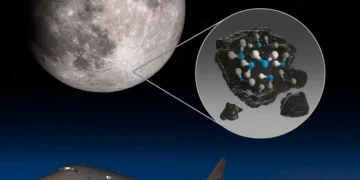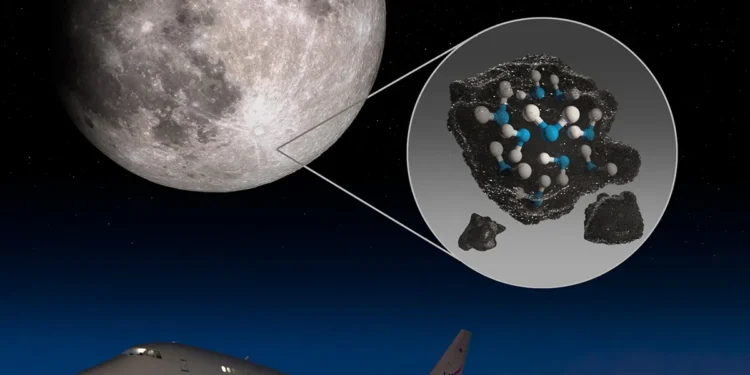The Moon, our closest celestial neighbor, has long intrigued scientists with its mysterious surface. Recently, researchers have uncovered exciting news: water and hydroxyl are far more widespread on the Moon than previously thought, even in sunlit areas. This discovery, powered by data from the Moon Mineralogy Mapper (M3) aboard India’s Chandrayaan-1 spacecraft, could revolutionize future lunar exploration and the search for sustainable resources. Let’s dive into why this finding is a game-changer for science and humanity’s return to the Moon.
Discovering Water and Hydroxyl Across the Lunar Surface
The discovery that water and hydroxyl are scattered across the Moon’s sunlit regions is a significant breakthrough. Using the M3 spectrometer, scientists were able to map water and hydroxyl on both the near and far sides of the Moon in greater detail than ever before. The Moon Mineralogy Mapper analyzes the infrared spectrum of reflected sunlight, which allows it to detect water molecules (H₂O) and hydroxyl groups (OH) within lunar rocks and soils. This instrument provided unprecedented insight, revealing that water isn’t just confined to the Moon’s permanently shadowed craters near the poles, but can also be found in sunlit areas across various latitudes.
Previously, the general consensus was that water was mainly found in the polar craters where it could remain frozen, shielded from the Sun. However, this study shows that water-rich rocks, excavated by meteor impacts, are scattered across the Moon, presenting new opportunities for future astronauts.
The Significance of Water on the Moon
The presence of water on the Moon is more than just a scientific curiosity—it’s a potential lifeline for future space exploration. Water is essential for sustaining human life, and it can be split into hydrogen and oxygen, which are critical for breathable air and rocket fuel. This makes the Moon not just a target for scientific discovery, but also a potential stepping stone for deeper space missions, including Mars.
Finding water near the equator is particularly important because this region receives abundant sunlight, making it ideal for solar-powered operations. The ability to extract water from rocks and soils near the equator could significantly reduce the logistical challenges of transporting resources across the lunar surface, thereby supporting longer and more sustainable human missions.
How Solar Wind Shapes Lunar Chemistry
One fascinating aspect of this discovery is the role of solar wind in creating hydroxyl on the Moon’s surface. Solar wind, a stream of charged particles emitted by the Sun, bombards the lunar surface, breaking down silicate minerals and creating hydroxyl through a process known as space weathering. This phenomenon helps explain why hydroxyl is found not just in water-rich areas but also spread across the Moon’s surface, contributing to the complex chemistry observed by the M3 spectrometer.
This process of hydroxyl formation is slow, occurring over thousands to millions of years, but it reveals the dynamic nature of the Moon’s surface. The findings suggest that while some water is slowly destroyed over time, hydroxyl persists, indicating that the Moon’s surface is far from static. It’s a continuously evolving landscape shaped by solar wind, meteor impacts, and volcanic activity.
Meteor Impacts and Volcanic Activity: Bringing Water to the Surface
Meteor impacts play a crucial role in the distribution of water on the Moon. When meteors strike the lunar surface, they excavate subsurface materials, including water-rich rocks, and expose them to the harsh environment of space. Over time, these rocks release water, which then interacts with solar wind, creating a diffuse layer of hydroxyl that spreads across the surface.
Volcanic activity, though less frequent, also contributes to this process. Ancient lunar volcanoes brought water-rich magma from the Moon’s interior to the surface, leaving behind deposits that still contain traces of water and hydroxyl today. This discovery is crucial for understanding the Moon’s geological history and how its internal processes have influenced the surface environment we see today.
The Future of Lunar Exploration: Extracting Water from the Moon
With the knowledge that water and hydroxyl are more widely available than previously thought, the next big challenge is figuring out how to extract these resources efficiently. Current technology allows for water to be harvested by heating lunar rocks and soils, releasing water vapor that can then be collected. However, this process requires significant energy, and future missions will need to develop more efficient methods to make this a viable option for sustained human presence.
Innovations in resource extraction technologies will be vital. For example, chemical processes that combine hydroxyl groups to form water and oxygen could provide a way to produce critical resources directly on the Moon. As NASA, international space agencies, and private companies like SpaceX look toward building lunar bases, these technologies will be at the forefront of enabling long-term human exploration.
Broader Implications: A Complex Lunar Surface
The discovery of widespread water and hydroxyl also sheds light on other mysterious features of the Moon, such as lunar swirls—bright, swirling patterns on the surface thought to be shaped by magnetic fields that shield the surface from solar wind. These areas are deficient in hydroxyl, suggesting that magnetic fields play a role in altering the Moon’s chemistry.
Understanding these interactions is key to piecing together the Moon’s complex geological past and its potential for future exploration. As we learn more about the distribution of water and hydroxyl, we can better target areas for scientific study and resource extraction, maximizing the effectiveness of future missions.
The Impact on Human Exploration and Space Industry
The discovery of water across the lunar surface is not just about scientific curiosity—it’s a cornerstone of future space exploration. If astronauts can extract water directly from the Moon, it would greatly reduce the need to haul heavy and costly supplies from Earth. This would make lunar missions more sustainable, economically feasible, and could eventually support a continuous human presence on the Moon.
The implications extend beyond human survival; the ability to produce fuel from lunar water could revolutionize space travel. Rockets could refuel on the Moon, using it as a launchpad for missions deeper into the solar system, including Mars and beyond. This could mark the beginning of a new era of space exploration, where the Moon serves as an interplanetary fuel station.
A Glimpse Into the Future
The idea of harvesting lunar water is not just science fiction—it’s quickly becoming a science fact. As nations and private companies set their sights on the Moon, understanding its resources will be crucial. From potential lunar bases to the broader goal of sustainable space exploration, the discovery of water and hydroxyl across the lunar surface is a monumental step forward.
But there is still much to learn. Future missions equipped with advanced technologies will be essential to map the distribution of water in even greater detail, develop efficient extraction methods, and unlock the full potential of lunar resources.
Conclusion: A New Dawn for Lunar Science
The Moon has always been a source of wonder, but this new discovery of widespread water and hydroxyl opens up exciting possibilities for the future. It’s not just about understanding our celestial neighbor better—it’s about leveraging this knowledge to build a sustainable presence on the Moon and beyond. By tapping into the Moon’s resources, we can transform it into a gateway to the solar system, making human exploration of Mars and other distant worlds a tangible reality.
As we continue to explore the Moon’s surface with advanced instruments and rovers, each new discovery brings us closer to realizing the dream of becoming a multi-planetary species. The Moon, once thought to be a barren world, is revealing itself to be far more complex and resource-rich than we ever imagined. So, let’s unravel the Moon’s secrets, one discovery at a time, and prepare for the next giant leap in space exploration.
Reference:
Clark, R. N., Pearson, N. C., McCord, T. B., Domingue, D. L., Livo, K. E., Boardman, J. W., Moriarty, D. P., Hendrix, A. R., Kramer, G., & Banks, M. E. (2024). The global distribution of water and hydroxyl on the Moon as seen by the Moon Mineralogy Mapper (M3).



















